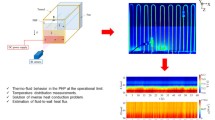Abstract
As technology becomes increasingly miniaturized, extremely localized heat dissipation leads to the challenge of how to keep these devices from overheating. A pulsating heat pipe (PHP) is an excellent cooling device based on the phase change of a working fluid. Experiments are performed to investigate the thermal performances of a Micro Pulsating Heat Pipe (MPHP) using different working fluids. The MPHP consists of 20 parallel channels made of a copper capillary tube with an internal diameter of 0.8 mm. The MPHP is filled with ethanol, deionized water and an aqueous solution of 1-butanol as working fluids, with different filling ratios (FRs) in the range 40–70 vol.%. The 1-butanol aqueous solution is known as a self-rewetting fluid, i.e. a dilute aqueous solution of alcohols with a number of carbon atoms higher than four (such as 1-butanol and pentanol). The surface tension of self-rewetting fluids decreases gradually with an increase in temperature, reaching a minimum around 60 °C, and subsequently increases gradually at higher temperatures. Therefore, at relatively high temperature self-rewetting fluids flow towards the regions at higher temperature due to the Marangoni effect. This flow should improve the boiling phenomenon, which is very important in the heat transfer mechanism of the MPHP. The experimental results indicate that, in the case of self-rewetting fluid, the stable oscillating motion in the MPHP arises at the heat load regime lower than that with water. In addition, the effective thermal conductivity of the MPHP with the highest concentration of self-rewetting fluid is higher than that with other fluids in the high heat load regime.













Similar content being viewed by others
Abbreviations
- A:
-
Cross section area (m2)
- FR:
-
Fill ratio of working fluid (vol.%)
- L:
-
Length between the heating and cooling section (m)
- Q:
-
Input power (W)
- R:
-
Thermal resistance (K/W)
- T:
-
Temperature (°C)
- λeff :
-
Effective thermal conductivity (W/m▪K)
- a:
-
Adiabatic
- c:
-
Cooling
- h:
-
Heating
- ave.:
-
Average
References
Abe, Y., Iwaski, A., Tanaka, K.: Thermal management with self-rewetting fluids. Microgravity Science and Technology. 16(1–4), 148–152 (2005)
Akachi, H., Motoya, S., Maezawa, S.: Thermal: Performance of Capillary Tunnel Type Flat Plate Heat Pipe, Proc. of 7th Int. Heat Pipe Conference, Albuquerque, NewMexico, (1995)
Bastakoti, D., Zhang, H., Cai, W., Li, F.: An experimental investigation of thermal performance of pulsating heat pipe with alcohols and surfactant solutions. Int. J. Heat Mass Transf. 117, 1032–1040 (2018a)
Bastakoti, D., Zhang, H., Li, D., Cai, W., Li, F.: An overview on the developing trend of pulsating heat pipe and its performance. Appl. Therm. Eng. 141, 305–332 (2018b)
Cheng, K.K., Park, C.: Surface tension of dilute alcohol-aqueous binary fluids: n-butanol/water, n-Pentanol/water, and n-Hexanol/water solutions. Heat Mass Transf. 53(7), 2255–2263 (2017)
Fumoto, K., Kawaji, M.: Improvement in pulsating heat pipes using a self-rewetting fluid: cases of 1-butanol and 1-pentanol. Thermal science and engineering. 19(1), 1–7 (2011)
Fumoto, K., Ishida, T., Kawanami, T., Inamura, T.: Experimental study on pulsating heat pipe using self-rewetting fluid as a working fluid: visualization of the thin liquid film and surface wave. Heat Pipe Science and Technology: An international Journal. 6(1–2), 65–76 (2015)
Gu, J., Kawaji, M., Futamata, R.: Microgravity performance of micro pulsating heat pipes. Microgravity Science and Technology. 16(1–4), 181–185 (2005)
Han, X., Wang, X., Zheng, H., Xu, X., Chen, G.: Review of the development of pulsating heat pipe for heat dissipation. Renew. Sust. Energ. Rev. 59, 692–709 (2016)
Hu, Y., Zhang, S., Li, X., Wang, S.: Heat transfer enhancement mechanism of pool boiling with self-rewetting fluid. Int. J. Heat Mass Transf. 79, 309–313 (2014b)
Hu, Y., Liu, T., Li, X., Wang, S.: Heat transfer enhancement of micro oscillating heat pipes with self-rewetting fluid. Int. J. Heat Mass Transf. 70, 496–503 (2014a)
Jin, S., Kim, S.J.: Comparison of the thermal performances and flow characteristics between closed-loop and closed-end micro pulsating heat pipes. Int. J. Heat Mass Transf. 95, 890–901 (2016)
JSME Date Book: Thermophysical Properties of Fluids 4th Edition. (1991)
Kim, J., Kim, S.J.: Experimental investigation on the effect of the condenser length on the thermal performance of a micro pulsating heat pipe. Appl. Therm. Eng. 130, 439–448 (2018)
Mameli, M., Marengo, M., Zinna, S.: Numerical investigation of the effects of orientation and gravity in a closed loop pulsating heat pipe. Microgravity Science and Technology. 24(2), 79–92 (2012)
Patel, V.M., Gaurav, M., Hemantkumar, B.: Influence of working fluids on startup mechanism and thermal performance of a closed loop pulsating heat pipe. Appl. Therm. Eng. 110, 1568–1577 (2017)
Qu, J., Wu, H., Cheng, O.: Start-up heat transfer and flow characteristics of silicon-based micro pulsating heat pipes. Int. J. Heat Mass Transf. 55, 6109–6120 (2012)
Savino, R., Fortezza, R., Piccolo, C.: Heat pipes with self-rewetting fluids under low-gravity conditions. Microgravity Science and Technology. 19(3–4), 75–77 (2007)
Savino, R., Anselmo, C., Paola, R.: Surface tension-driven flow in wickless heat pipes with self-rewetting fluids. Int. J. Heat Fluid Flow. 30(2), 380–388 (2009)
Sitar, A., Golobic, I.: Heat transfer enhancement of self-rewetting aqueous n-butanol solution boiling in microchannels. Int. J. Heat Mass Transf. 81, 198–206 (2015)
Yamagami, K., Fumoto, K., Savino, R., Kawanami, T., Inamura, T.: Heat transfer characteristics of flat plate pulsating heat pipe using self-rewetting fluids, proc. of joint 18th IHPC and 12th IHPS, Jeju, Korea, 12–16 (2016)
Yoon, A., Kim, S.J.: Understanding of the thermos-hydrodynamic coupling in a micro pulsating heat pipe. Int. J. Heat Mass Transf. 127, 1004–1013 (2018)
Author information
Authors and Affiliations
Corresponding author
Additional information
Publisher’s Note
Springer Nature remains neutral with regard to jurisdictional claims in published maps and institutional affiliations.
This article belongs to the Topical Collection: Heat Pipe Systems for Thermal Management in Space
Guest Editors: Raffaele Savino, Sameer Khandekar
Rights and permissions
About this article
Cite this article
Fumoto, K., Sasa, M., Okabe, T. et al. Research on Heat Transfer Performance of the Open-Loop Micro Pulsating Heat Pipe with Self-Rewetting Fluids. Microgravity Sci. Technol. 31, 261–268 (2019). https://doi.org/10.1007/s12217-019-9683-4
Received:
Accepted:
Published:
Issue Date:
DOI: https://doi.org/10.1007/s12217-019-9683-4




